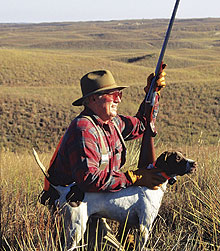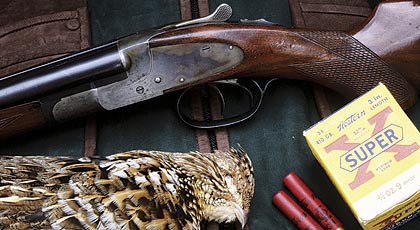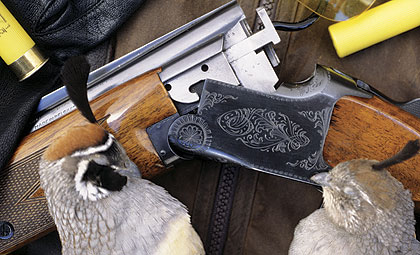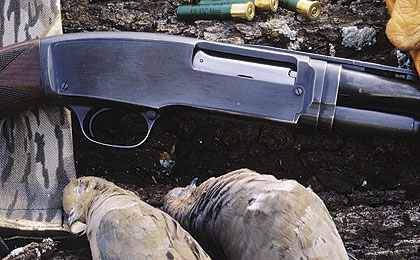The price is still right for a lot of classic guns you'll enjoy--and feel honored--taking afield.
By Layne Simpson
 A Fox Sterlingworth like the 1920s vintage gun I am hunting with here is still quite affordable. |
Some hunters see their shotguns as nothing more than tools; they couldn't care less who made them, when they were made or how they look so long as they get the job done.
There is absolutely nothing wrong with that attitude. In fact, some of my best friends feel the same way about their guns and I have never held it against them. When a hole needs digging, they reach for the shovel; when it is time to go hunting, they reach behind the door for their gun. With them, it never gets any more complicated or emotional than that.
Fewer in number are those of us who enjoy being in the field with a fine gun as much as we enjoy the actual hunting. And since we feel the same way about fine dogs, especially the old ones, surely we cannot be all bad.
Fine old guns can be neatly divided into two groups. The first group is made up of the extremely rare and the sinfully expensive. More often than not, those pieces are bought for looking at but not for shooting. Let's call them collectible guns and leave them for those who can afford them.
The second group consists of guns most of us consider to be classics but due to various and sundry reasons, they do not cost an arm and a leg. This puts them within reach of anyone who wants one badly enough. Some of those guns have been out of production for many hunting seasons and that alone can make them desirable.
Some, like the Parker double and the Winchester Model 12, have been reproduced in limited quantities. A few, like the Remington Model 1100, have been on the brink of obsolescence for several years but the ongoing demand from hunters has kept them alive.
Regardless of which category they fit into, I call these guns collectible shooters. They should not be bought with the hope of turning a profit overnight because their value on the used gun market usually increases at about the same speed as molasses flowing through a snowbank.
 An L.C. Smith in .410 is both scarce and pricey, but the same gun in 12, 16 and 20 gauge is less expensive than some of the better Spanish doubles being imported today. |
But it is highly unlikely that their value will ever decrease, so you can believe me when I say money is spent more wisely here than on leather seats for a new automobile or for a new computer. And besides, everybody knows fine old guns are bought for love and not for money.
So what are some of the affordable old guns sentimental people like me love to own and hunt with? To cover all the great classics in the detail they deserve would fill a very large book and since my allotted space is quite a bit more limited than that, the best I can do is include some of my picks in the four categories. If I fail to mention yours, it is not because I dislike your gun but probably because I ran out of room before I got to it.
A double-gun man at heart and patriotic to boot, I'll start with names like L.C. Smith, Fox, Lefever, Winchester, Parker, Ithaca and yes, even Iver Johnson. Just about any gun made by one of those companies is worthy of filling a slot in your hunting battery.
The Winchester Model 21 might just be the strongest side-by-side ever built, but its price has skyrocketed beyond reason lately and that leaves half a dozen or so in what I consider to be the affordable category. Exceptions are doubles in the smaller gauges. They are more expensive because as a rule, the smaller the gauge, the fewer the number built. L.C. Smith, for example, built only about 2,665 .410s, which explains why one of those can cost about 10 times more than the same gun in a 12 gauge.
 Because it is still in production, the Remington 1100 may not actually be a collectible shooter at this very moment but since its days are numbered, those in .410 and 28 gauge are destined to be just that. |
I absolutely love .410s and my L.C. Smith and an Iver Johnson Skeet-er in that caliber are two of the last guns I will ever turn loose. The fellow who owned Iver Johnson back in the 1930s was an avid skeet shooter so he built the Skeet-er in all the popular gauges, each perfectly scaled in size for its chambering. One in .410 will bring about as much as an L.C. Smith in the same caliber and a 28-gauge gun may be even more scarce, but the 12s and 20s, while also a bit scarce, will not break the bank.
The L.C. Smith in its larger gauges is still quite affordable, as is the Fox Sterlingworth. Since it is built on the smaller 20-gauge frame, a 16-gauge Fox is especially nice and a good one costs less than some of the better Spanish doubles being imported today. The Parker Trojan has its fans and rightfully so. Between the two, I prefer the Sterlingworth because I consider it more durable, but you know what they say about opinions.
Now for the over-unders. Everything considered (and this includes
waterfowling and clay target shooting), I think the Remington Model 3200 is the best over-under shotgun ever built in America. The old Remington Model 32 was good but the Model 3200 is better in a number of ways, including its trigger. The price is still right too.
But as much as I like the Model 3200 and as much as I like American-built guns, I will have to admit the lighter weight of the old Browning Superposed makes it a better gun for upland hunting. My father paid $397.50 for his first one back in the 1960s and even today a good used one is still quite affordable.
For the money, I consider the Remington 3200 and Browning Superposed to be top guns among collectible shooters but the sleeper over-under of yesteryear is the Japanese-made Winchester Model 101. In 1966 I bought the first 20-gauge 101 to appear in the gun rack at Pepper's Feed & Seed in Easley, South Carolina, and it cost me the princely sum of $283.95. I still have it and even after digesting many thousands of rounds in both North and South America, that fine old gun has yet to break a single part.
The slide-action discussion will take a bit longer. Even though I am not a pumpgun man at
heart, I do enjoy shooting several. The Winchester Model 97 deserves to be included here because it is one of the best-handling, smoothest-swinging shotguns ever produced for the workingman. Nobody ever accused it of being pretty, but it worked under conditions that caused other shotguns to choke and that alone was enough to make everybody want one. There was a time when good used 97s were a dime a dozen and while cowboy action shooters have driven up prices a bit, they are still quite reasonable when you consider what you get for your money.
 There was a time when the Browning Superposed owned the over-under shotgun market and plenty of good used ones are still available at decent prices. |
Based on sales numbers alone, the Remington Model 870 is the world's most successful slide-action shotgun and it is every bit as good as they say it is. But to me, the classic among Remington pumps is the Model 31. Once described in Remington advertisements as the gun with the ball-bearing action, it became even smoother after being shot a bit. The 31 was Remington's first bottom-ejecting pump gun and while it never became as popular among hunters as the Winchester model 12, it gave that gun a big run for its money on the trap and skeet fields of America.
Which brings me to what I consider to be the best of the best in pump guns. Actually, there are two of them. Winchester often described one as the Perfect Repeater while I have been known to describe the other as America's Sweetheart. I'm talking about the Model 12 and the Model 42.
 Any bird hunter who handles the Winchester Model 42 and doesn't fall in love with it has a heart of stone. |
The Model 12 was available in 12, 16, 20 and 28 gauges. The Model 42 was made only in .410, the cartridge for which it was specifically designed. Anyone who picks up a Model 42 for the first time and does not fall head over heels in love has a heart of stone. And anyone who says the Model 12 really isn't as perfect as a repeater can possibly be either has not shot one or does not care for pump guns.
The real prize among Model 12s is the 16-gauge; built on the 20-gauge receiver, it is actually lighter than the same gun in 20-gauge because its barrel is thinner at the breech. It truly does carry like a 20 and shoot like a 12. Here's a tip: If you just want a good hunting gun and don't care where it was made, the limited-production Model 12s in 20 and 28 gauge and the Model 42s sold by Browning a few years back are as good as the real thing and they are extremely affordable to boot.
We finally come to the semiautomatics. Three million Browning A-5s were manufactured in Belgium, Japan and America (yep, Remington built close to 65,000 of them for Browning). On top of that, Remington also built and sold 850,000 near copies of the same gun, but called it the Model 11. Considering those production numbers, few would argue against the fact that John Browning's "Automatic-Five" shotgun ruled the autoloader roost among America's hunters and it did so for a good 50 years. So if the A-5 was king during the first half of the 20th century, what gun booted it from its throne and went on to reign over the second half of the century? If you know your shotguns, you know the answer to that question is the Remington Model 1100.
The Model 1100 was introduced in 1963 and within 20 years three million had been built. The plan at Remington was to discontinue production soon after introducing the Model 11-87 in 1987 but popular demand simply would not allow them to do so. Production numbers for the Model 1100 are approaching four million units as you read this, making it the most successful semiautomatic ever built by anybody anywhere in the world.
As far as I know, it and its predecessor, the Model 11-48, are the only two autoloading shotguns to ever be available in all five popular chamberings--12, 16, 20, 28 and .410. Last time I looked, the Model 1100 was still available in those five bore sizes although production of those in .410 and 28 is quite limited.
| HOW MUCH DO THEY COST |
|---|
When all is said and done, any gun is worth what someone is willing to pay for it so it is with some reservation that I get into prices. A few minutes of surfing the Internet will give you an even better idea of what you will have to pay, but here are a few ballpark figures for used 12-gauge field-grade guns in sound condition. You probably won't find a jewel in mint condition at those prices, but look hard enough and you should find a collectible shooter capable of rewarding you with many years of service.
Browning A5 $ 800Browning Superposed $1,400Fox Sterlingworth $1,200Iver Johnson Skeet-er $1,800L.C. Smith $1,000Parker Trojan $1,500Remington Model 1100 $600Remington Model 3200 $800Winchester Model 12 $700 Winchester Model 21 $3,000Winchester Model 42 $1,000Winchester Model 59 $600Winchester Model 97 $700 |
There was a time when I had very little use for a shotgun that held more than two shells but my mind changed when I shot my first Model 1100. It was the first shotgun of its type I had ever fired that felt as good as my doubles.
Because it is still in production some will say the Model 1100 should not at this time be classified as a collectible shooter and if it were available only in 12-gauge and 20-gauge I would agree. But I believe its days are numbered and once production ceases, those in .410 and 28-gauge (and possibly the 16s as well) will eventually become some of the most desirable mass-produced guns ever built.
One other old-timer deserves mention in the same category, and it is the Winchester Model 59. It was introduced in 1960 and its barrel was made by wrapping 500 miles of glass fiber around a thin steel tube. That, along with its aluminum receiver, kept the weight of the gun at about 61?2 pounds, which was extremely light for a 12-gauge gun in those days.
The Versalite choke system with its interchangeable, screw-in tubes was a revolutionary idea back then but it is old hat today because just about every shotgun has them. If I had to do all the rest of my ruffed grouse hunting with a 12-gauge autoloader, I would not complain a bit if it were a Model 59.
Layne Simpson's new 256-page hardback book, Shotguns and Shotgunning, contains 35 chapters and over 200 color photos. An autographed copy is available for $39.99 plus $6 s&h from Highcountry Press, Dept. GD, 306 Holly Park Lane, Simpsonville, SC 29681.






